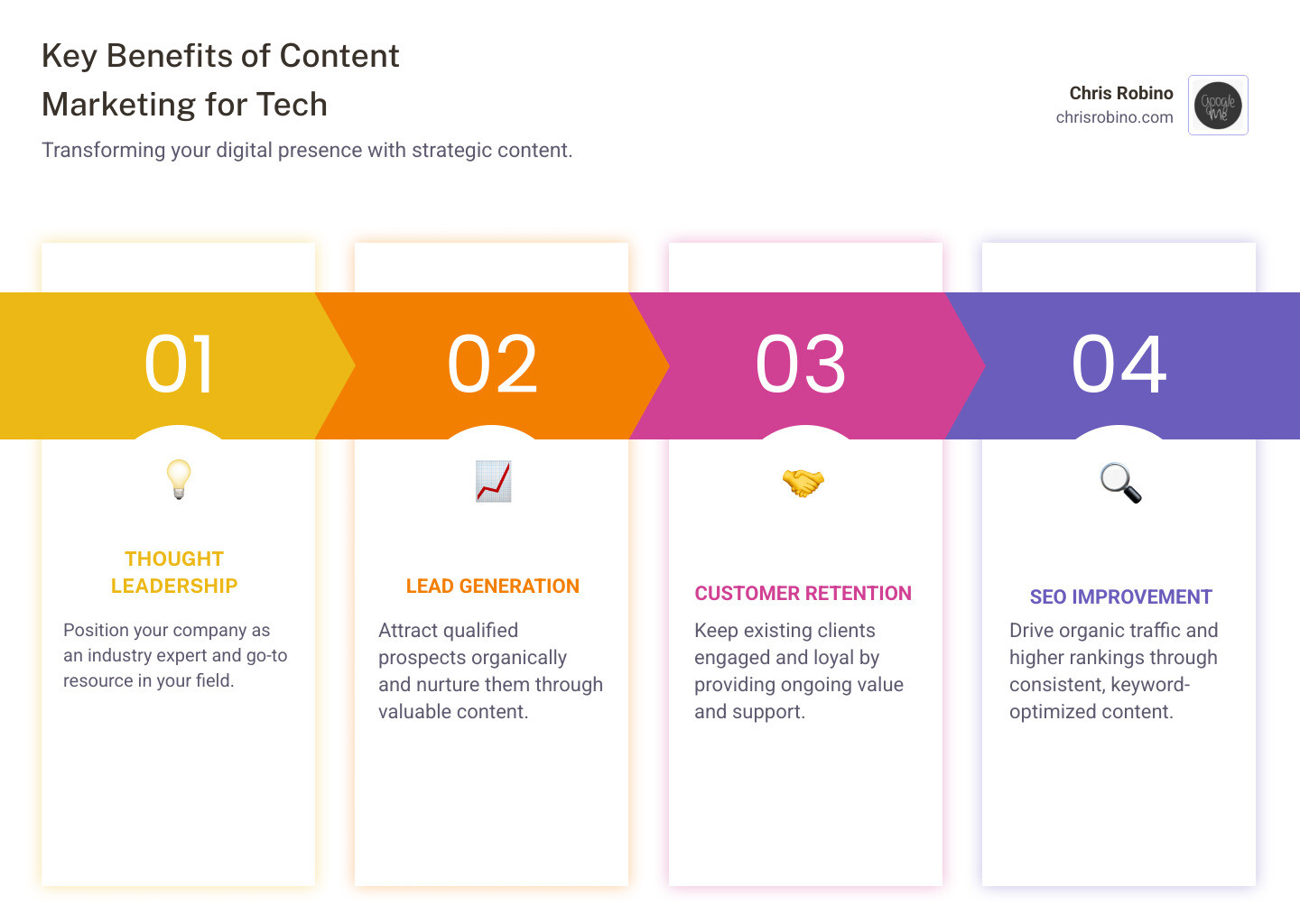Why Enterprise SEO Is Non-Negotiable for Large Companies
For large companies, sustainable growth depends on being findable at scale. Enterprise websites span thousands of pages, multiple brands and markets, complex governance, and frequent product changes. Without a rigorous, scalable SEO program, even best-in-class offerings get buried, leaving market share and revenue on the table.
Enterprise SEO goes beyond keywords. It’s the operating system for organic growth: technical excellence, content systems, SERP ownership, analytics discipline, and cross-functional execution. Done right, it compounds—reducing acquisition costs, strengthening brand preference, and insulating performance from paid media volatility. Recent search engine statistics show that over 90% of online experiences begin with a search engine, making SEO critical for enterprise visibility.
Quick Answer: Top Enterprise SEO Strategies
- Document an SEO strategy tied to revenue, pipeline, and market share.
- Build technical foundations for crawl efficiency, rendering, and Core Web Vitals.
- Scale intent-driven content with strong entity coverage and clear information architecture.
- Establish authority using E-E-A-T signals, expert bylines, and structured data.
- Own SERP real estate with schema, images, and video.
- Operationalize SEO via governance, templates, and pre-launch controls.
- Apply AI and automation for speed while preserving human quality control.
- Measure what matters: non-brand growth, ranking distribution, and organic revenue impact.
The payoff is durable: greater qualified traffic, improved conversion efficiency, and a compounding moat built on technical health, topical authority, and organizational muscle.

Core Enterprise SEO Strategies for Large Companies
The gap between good and great enterprise SEO is execution at scale. Winning programs align leadership, engineering, content, design, and analytics around a documented roadmap and shared KPIs. Below are five strategies that consistently deliver outsized impact for large organizations.
1. Build a Strategic Foundation: Governance, Goals, and a Roadmap
Start with clarity on business outcomes: market share in priority categories, pipeline and revenue from organic, and brand health. Translate those into SEO objectives and leading indicators (non‑brand traffic, ranking distribution, share of search) with clear targets.
- Create governance: a Center of Excellence, RACI, and operating cadence (weekly triage, monthly roadmap, quarterly planning). Make SEO a required step in product and content releases.
- Inventory your digital footprint: domains, subdomains, apps, documentation, support, and international sites. Decide on a domain strategy (folders vs subdomains) grounded in authority consolidation and operational simplicity.
- Build a backlog and calendar: technical debt, content gaps by intent and persona, structured data coverage, and SERP feature opportunities. Prioritize with an impact/effort framework and set SLAs with engineering and content teams.
- Systematize quality: editorial guidelines, on‑page standards, internal linking rules, and schema templates. Bake SEO requirements into the Definition of Done for new templates, components, and pages.
The result is consistency: fewer fire drills, faster time‑to‑value, and predictable growth.
2. Establish Authority with High‑Value, Search‑Optimized Assets
Authority is earned by covering topics comprehensively, demonstrating expertise, and proving real‑world value. Large companies can win here by building scalable content systems:
- Pillar and cluster architecture: create definitive pillar pages for your core categories and support them with tightly interlinked cluster content. Use clear taxonomy and breadcrumbs so users and crawlers understand relationships.
- High‑intent pages that convert: optimize solutions pages, product pages, comparison pages, and industry pages with unique value, proof (case studies, testimonials, data), and clear CTAs.
- Technical and support content: documentation, implementation guides, and troubleshooting articles capture late‑stage demand and reduce support costs. Mark up with structured data and keep versions synchronized.
- Case studies that show impact: quantify outcomes, detail the implementation, and surface relevant metrics. Author with named experts to reinforce trust.
- Thought leadership with E‑E‑A‑T: publish original insights and research backed by credible authorship, clear sourcing, and editorial transparency. Maintain author bios and update histories.
Invest in maintenance. Enterprise sites decay without upkeep—retire or consolidate underperforming content, refresh winning assets, and preserve link equity with careful redirect strategies.
3. Elevate Visibility with Storytelling, Media, and SERP Formats
Winning the click increasingly means winning the SERP. Enhance content with formats that earn visibility and drive engagement.
- Structured data at scale: implement JSON‑LD modules across templates (organization, product, how‑to, article, video, job posting, FAQ where appropriate). Centralize management to reduce drift and ensure consistency.
- Image SEO: compress and serve next‑gen formats, provide descriptive filenames and alt text, and include images that genuinely add value. Image packs can drive meaningful traffic in many verticals.
- Video SEO: host and embed with transcripts, captions, and chapters. Use schema to enhance discovery and feature videos on relevant pages where they clarify complex topics or workflows.
- Storytelling for differentiation: explain not just what your solution is but why it matters, who it helps, and how it works. Clear narratives increase time on page and link‑worthiness—both strong quality signals.

4. Map SEO to the Full Customer Journey
Enterprise buyers touch dozens of pages and formats before converting. Build search experiences that meet them at every step.
- Awareness: capture problem‑based queries with educational content, industry trend analysis, and category explainers. Optimize for clarity, scannability, and entity coverage so pages qualify for broad discovery.
- Consideration: target solution comparisons, integration needs, and use‑case‑specific queries with detailed guides, feature breakdowns, and ROI narratives. Internal linking should guide readers toward relevant product and demo pages.
- Decision: strengthen product pages with specs, pricing transparency where possible, and proof. Add calculators, demos, and implementation timelines to accelerate purchase decisions.
- Post‑purchase: build searchable onboarding, best practices, and advanced tutorials. This content reduces churn, boosts expansion, and generates long‑tail traffic while reinforcing product value.

Complement the content strategy with clear information architecture, helpful navigation, and breadcrumb trails. The easier it is for users to progress, the easier it is for crawlers to understand and rank your site.
5. Future‑Proofing: Integrate AI and Automation into Enterprise SEO
AI and automation multiply throughput, but they must be implemented with strong guardrails.
- Research and planning: use clustering and pattern detection to identify opportunity spaces, query intent, and seasonality. Feed these insights into your roadmap and editorial briefs.
- Content operations: accelerate outlines, FAQs, and schema drafts with AI, while ensuring human review for brand voice, accuracy, and compliance. Establish a red‑team process for claims and sensitive topics.
- Technical monitoring: automate detection of indexing anomalies, template regressions, and internal linking breaks. Integrate alerts into engineering workflows for rapid remediation.
- Personalization and internal links: algorithmically suggest related content and cross‑links based on entity proximity and user behavior, then QA the outputs for relevance.
The goal isn’t full automation; it’s smarter humans supported by reliable systems. Maintain human oversight for anything user‑facing and measure the impact of automation with controlled tests.
Measuring Success and Overcoming Common Problems
Great enterprise SEO couples high‑quality execution with disciplined measurement and iteration. Treat organic like a product: instrument it, test it, and improve it continuously.
6. Data‑Driven Optimization: KPIs for Enterprise SEO
Focus on metrics that connect to business outcomes and reveal where to optimize.
- Non‑brand organic traffic and share of search: shows category growth independent of brand demand.
- Revenue and pipeline from organic: attribute with a consistent model and track by product, segment, and region.
- Ranking distribution and visibility: monitor the share of URLs in top‑3, top‑10, and page‑one positions for priority topics.
- CTR by query and template: identify where better titles, descriptions, and rich results can lift clicks without new content.
- Index coverage and crawl efficiency: track pages discovered vs indexed, crawl waste on parameters/facets, and error rates.
- Core Web Vitals and performance: sitewide and by template, tied to organic conversion rate.
- Content velocity and freshness: production throughput, update cadence for top assets, and decay recovery rate.
- International performance: per‑locale traffic, rankings, and conversion, plus hreflang integrity.
Build a single source of truth combining analytics, search and crawl data, log files, and business outcomes in your BI environment. Use experimentation—template A/Bs and controlled rollouts—to quantify lifts from on‑page changes, internal linking, schema, and performance improvements.
Even elite programs face headwinds. Common challenges and fixes include:
- Crawl waste from faceted navigation: constrain combinatorial URLs with robots rules, noindex where appropriate, canonicalization, and smart internal linking. Offer curated filters that generate indexable, valuable collections.
- Duplicate and near‑duplicate content: define canonical masters, standardize pagination, and consolidate thin or overlapping pages. For international sites, implement hreflang correctly and localize meaningfully (not just language swaps).
- JavaScript rendering issues: prefer server‑side rendering or hybrid approaches, pre‑render critical templates, and ensure content and links are available without client‑side dependencies.
- Slow and unstable pages: improve Core Web Vitals through image optimization, code splitting, font loading strategies, caching, and edge delivery. Measure by template and fix regressions at the component level.
- CMS and template constraints: ship SEO‑ready templates with editable meta, headings, schema slots, and internal link modules. Add pre‑launch checklists to the release pipeline and require SEO sign‑off for new components.
- Site migrations and rebrands: run phased plans with parity audits, comprehensive redirect maps, log‑based monitoring, and rollback options. Protect top‑performing URLs and test in lower environments before cutover.
- Organizational silos: establish an SEO guild across marketing, product, engineering, and regional teams. Share dashboards, set joint OKRs, and hold regular training so decisions consider organic impact.
- Schema and metadata drift: manage JSON‑LD centrally, version it, and audit coverage automatically. Keep titles, descriptions, and alt text within standards and test at scale.
- Budget pressure: prioritize initiatives with proven lift—template improvements, internal linking, content refreshes, and performance fixes often outperform net‑new builds on time‑to‑impact.
A 90‑day action plan to build momentum:
- Weeks 1–2: baseline measurement, crawl and log diagnostics, and performance benchmarking. Align on KPIs and targets.
- Weeks 3–6: fix high‑impact technical issues by template; roll out schema modules; refresh top decaying pages; establish governance and release checklists.
- Weeks 7–10: launch internal linking improvements across priority clusters; publish two to three high‑intent pages; pilot controlled title/description tests.
- Weeks 11–13: evaluate results, scale what works, and lock the roadmap for the next quarter.
Enterprise SEO rewards consistency. With strong governance, robust technical foundations, and a pipeline of high‑intent content, large companies can build an organic growth engine that compounds year after year.
